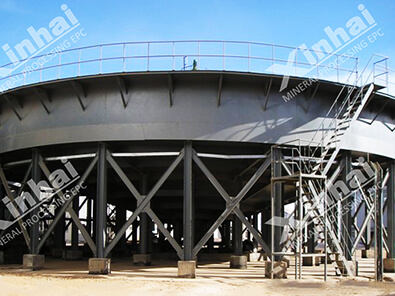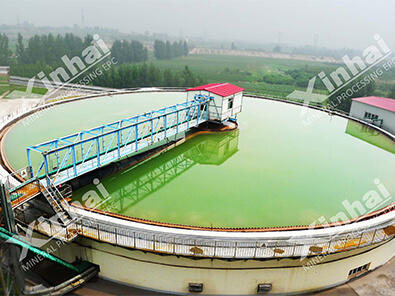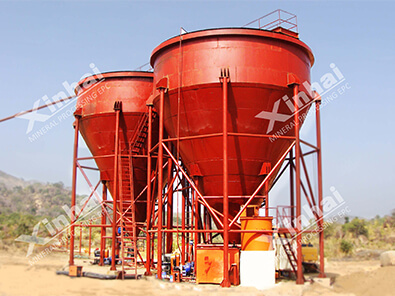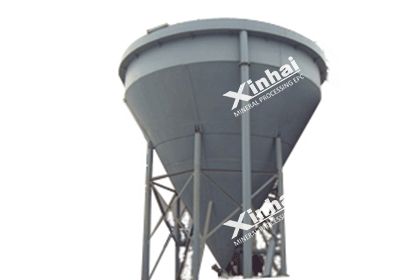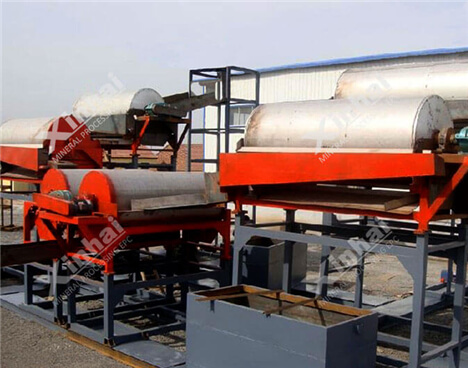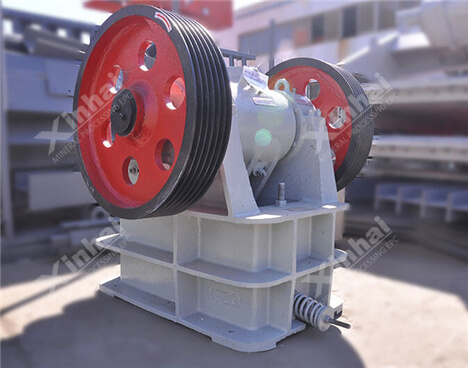A Comprehensive Guide to Thickener Maintenance
 Essow
Essow
 Aug 28, 2023
Aug 28, 2023
 4369
4369
If you want to know more details about equipment, solutions, etc, please click the button below for free consultation, or leave your requirements!
Thickeners play a crucial role in mineral processing operations by facilitating the separation of solids from liquids and maximizing the efficiency of various industrial processes. As essential components in the thickening process, these machines require regular and meticulous maintenance to ensure their optimal performance and longevity.
This article aims to provide a comprehensive guide to thickener maintenance, covering key aspects such as inspection, lubrication, component maintenance, and troubleshooting. By implementing proper maintenance practices, operators can minimize downtime, extend the lifespan of their equipment, and enhance overall operational efficiency.
01 Importance of Thickener Maintenance
BackThe importance of thickener maintenance cannot be overstated in mineral processing operations. Here are some key reasons why thickener maintenance is crucial:
1. Preventing Costly Breakdowns and Downtime
Regular maintenance helps identify and address potential issues before they escalate into major problems. By conducting inspections, lubricating components, and performing necessary repairs, operators can prevent unexpected breakdowns that can lead to costly downtime. Unplanned shutdowns can result in significant financial losses due to halted production, delayed shipments, and increased labor costs.
2. Maximizing Operational Efficiency
Well-maintained thickeners operate at peak efficiency, facilitating optimal solid-liquid separation. Efficient thickening processes result in higher underflow densities, which reduce the volume of material that needs to be handled or disposed of. This, in turn, minimizes water and chemical consumption, leading to cost savings and environmental benefits. Moreover, a properly functioning thickener ensures consistent and reliable performance, enabling smooth operations throughout the mineral processing circuit.
3. Enhancing Process Performance and Product Quality
Thickening is a critical step in various industrial processes, including mineral processing, waste management, and chemical production. Maintaining thickeners in good condition ensures that the desired process parameters are achieved consistently. For example, in mineral processing, an optimized thickening process can result in higher recoveries of valuable minerals and better product quality. By maintaining the efficiency and reliability of thickeners, operators can achieve their production targets and deliver high-quality products to customers.
4. Extending Equipment Lifespan
Regular maintenance extends the lifespan of thickening equipment. By identifying and addressing wear, corrosion, and other forms of deterioration, operators can prevent irreversible damage and premature equipment failure. This not only saves replacement costs but also avoids the need for emergency equipment procurement, which can lead to delays in operations. A longer equipment lifespan translates into better return on investment and improved overall profitability.
5. Ensuring Safety and Environmental Compliance
Thickener maintenance plays a crucial role in ensuring the safety of personnel and compliance with environmental regulations. Regular inspections help identify potential safety hazards such as loose or damaged components, leaks, or structural weaknesses. Addressing these issues promptly minimizes the risk of accidents and injuries. Additionally, well-maintained thickeners are less likely to experience spills or leaks that can harm the environment or result in regulatory non-compliance.
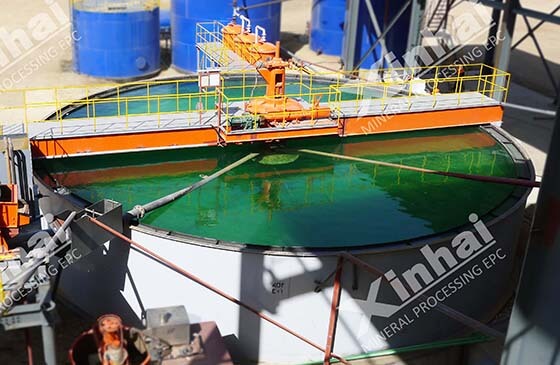
(Thickener in a gold processing plant)
02 Inspection and Monitoring
BackInspection and monitoring are vital aspects of thickener maintenance that help ensure the optimal performance and reliability of the equipment. Here are some key details about inspection and monitoring:
1. Visual Inspections
Regular visual inspections should be conducted on thickeners to assess their overall condition. This involves visually examining various components such as the drive mechanism, rake arms, discharge cone, and other critical parts. Visual inspections help identify signs of wear, corrosion, misalignment, leakage, or any other visible abnormalities. These inspections should be performed at scheduled intervals as part of a comprehensive maintenance program.
2. Advanced Monitoring Techniques
In addition to visual inspections, advanced monitoring techniques can provide valuable insights into the condition of thickeners. Two commonly used techniques are vibration analysis and oil analysis.
· Vibration Analysis
Vibration analysis involves monitoring the vibration levels and frequencies of various components of the thickener. By analyzing vibration patterns, it is possible to detect abnormalities such as unbalanced loads, misalignment, loose components, or excessive wear. Vibration sensors are strategically placed on key components such as the drive unit, gearboxes, and bearings to capture data for analysis. Early detection of vibration anomalies allows maintenance teams to take proactive measures, such as re-balancing components or tightening loose parts, to prevent further damage or failure.
· Oil Analysis
Oil analysis involves regularly sampling and analyzing the lubricating oil used in the thickener. This analysis helps identify potential issues such as contamination, degradation, or inadequate lubrication. By monitoring the oil's viscosity, presence of contaminants, and the condition of additives, maintenance teams can assess the health of the lubrication system and take appropriate actions, such as changing the oil, cleaning filters, or addressing lubrication deficiencies. Oil analysis provides valuable insights into the overall condition of the thickener and helps prevent premature wear and component failure.
3. Documentation and Record-Keeping
It is essential to maintain a comprehensive record of inspection and monitoring activities. This includes documenting findings, observations, measurements, and any maintenance actions taken. Proper documentation allows for historical tracking of equipment performance, identification of recurring issues, and assessment of maintenance effectiveness over time. It also serves as a reference for future inspections and helps in maintaining a proactive maintenance schedule.
4. Training and Expertise
Conducting thorough inspections and effectively monitoring thickener performance require trained personnel with expertise in the equipment and its maintenance. Operators should ensure that their maintenance teams receive adequate training on inspection techniques, monitoring methods, and analysis of collected data. This empowers them to identify potential problems accurately, make informed decisions, and execute necessary maintenance tasks effectively.
By implementing regular visual inspections, utilizing advanced monitoring techniques, maintaining comprehensive records, and investing in training and expertise, operators can ensure that their thickeners are closely monitored and any potential issues are identified and addressed promptly. This proactive approach to inspection and monitoring contributes to the overall reliability, efficiency, and longevity of thickening equipment.
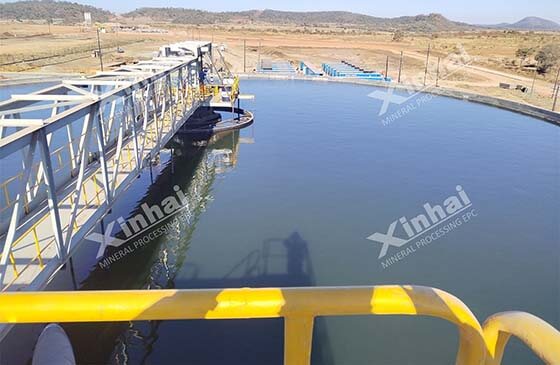
(Thickener in a lithium plant)
03 Lubrication and Component Maintenance
BackLubrication and component maintenance are critical aspects of thickener maintenance that contribute to the smooth operation and longevity of the equipment. Here are some key details about lubrication and component maintenance:
1. Lubrication:
· Importance of Lubrication
Proper lubrication is essential for reducing friction, minimizing wear, and ensuring the smooth operation of moving parts in thickeners. Lubricants create a protective film between surfaces, preventing direct metal-to-metal contact and reducing the risk of damage or failure. Effective lubrication also helps dissipate heat generated during operation, further enhancing equipment performance and lifespan.
· Lubrication Intervals
Establishing regular lubrication intervals is crucial. The frequency of lubrication depends on factors such as operating conditions, equipment design, and the manufacturer's recommendations. Lubrication schedules should be followed diligently to ensure that critical components receive the necessary lubrication at appropriate intervals.
· Suitable Lubricants
Selecting the right lubricants is important for optimal thickener performance. Different components may require specific types of lubricants, such as grease or oil, based on factors like load capacity, temperature range, and compatibility with materials. It is crucial to use high-quality lubricants that meet the manufacturer's specifications and are suitable for the operating conditions of the thickener.
· Application Techniques
Proper application of lubricants is essential to ensure effective coverage and distribution. Lubricants should be applied following the manufacturer's guidelines, considering factors such as quantity, method (e.g., manual or automated application), and specific lubrication points. Care should be taken to avoid over-lubrication, which can lead to excess buildup or contamination.
2. Component Maintenance
· Drive Unit
The drive unit of a thickener is a critical component responsible for rotating the rake arms and driving the thickened slurry towards the underflow. Regular inspection and maintenance of the drive unit are essential to ensure its proper functioning. This may involve checking the condition of gears, lubrication of gearboxes, inspecting couplings or belts, and conducting alignment checks.
· Shaft and Bearings
The shaft and bearings in a thickener enable the smooth rotation of the rake arms. Regular inspection of these components is necessary to detect any signs of wear, misalignment, or damage. Lubrication of bearings should be performed according to the manufacturer's recommendations, and worn or damaged bearings should be replaced promptly to prevent further complications.
· Rake Blades and Scraper Blades
Rake blades and scraper blades are responsible for moving settled solids towards the discharge cone in a thickener. These components can experience wear or damage over time. Regular inspection and replacement of worn or damaged blades are important to maintain efficient solids removal and prevent interference with the thickening process.
· Structural Integrity
The overall structural integrity of the thickener should be assessed periodically. This includes inspecting the tank, supports, and other structural elements for signs of corrosion, fatigue, or deformation. Any structural issues should be addressed promptly to prevent safety hazards and maintain the equipment's stability and reliability.
3. Maintenance Practices
· Adhering to Manufacturer's Guidelines
It is crucial to follow the manufacturer's guidelines and recommendations for lubrication and component maintenance. These guidelines provide valuable insights into the specific requirements of the equipment and help ensure proper lubrication techniques and maintenance practices.
· Scheduled Maintenance
Establishing a scheduled maintenance program is essential to ensure that lubrication and component maintenance tasks are performed regularly and consistently. This program should outline the frequency of inspections, lubrication intervals, and component maintenance activities based on the manufacturer's recommendations and the operating conditions of the thickener.
· Documentation and Tracking
Maintaining detailed records of lubrication and component maintenance activities is important. This includes documenting lubrication procedures, lubricant types and quantities used, inspection findings, maintenance tasks performed, and any issues or anomalies encountered. These records serve as a valuable resource for tracking maintenance history, identifying trends, and planning future maintenance activities.
By prioritizing proper lubrication techniques and implementing routine component maintenance practices, operators can ensure the smooth operation, reliability, and longevity of thickeners. Regular inspection, lubrication, and maintenance of critical components contribute to the overall performance and efficiency of the equipment, reducing the risk of breakdowns and extending its lifespan.
04 Troubleshooting and Problem Resolution
BackTroubleshooting and problem resolution are crucial aspects of thickener maintenance. When issues arise, it is important to identify the root causes and implement effective solutions. Here are some key details about troubleshooting and problem resolution:
1. Problem Identification
· Observation and Analysis
When a problem occurs, it is essential to carefully observe and analyze the symptoms to identify the underlying issue. This may involve examining operational data, reviewing maintenance records, and conducting visual inspections. Gathering relevant information helps in narrowing down the possible causes and developing an appropriate troubleshooting strategy.
· Root Cause Analysis
Root cause analysis is a systematic approach to identify the fundamental reason behind a problem. It involves investigating the contributing factors, examining the sequence of events, and determining the underlying cause. Techniques such as the "5 Whys" method or fishbone diagrams can be used to delve deeper into the problem and uncover its root cause.
2. Troubleshooting Techniques
· Systematic Approach
Troubleshooting should follow a systematic approach to ensure that all potential causes are considered. This may involve checking specific components, testing various systems, or reviewing operating parameters. By methodically eliminating potential causes one by one, operators can narrow down the root cause and focus on resolving the problem effectively.
· Collaboration and Expertise
Troubleshooting complex issues often benefits from collaboration among team members and leveraging their expertise. Different individuals may bring diverse perspectives and experiences to the table, leading to a more comprehensive analysis and problem-solving process. Consulting with equipment manufacturers, maintenance experts, or industry professionals can also provide valuable insights and guidance.
· Testing and Data Analysis
Utilizing testing equipment and analyzing relevant data can aid in troubleshooting. For example, vibration analysis, oil analysis, or performance data can provide valuable information about the condition of components and systems. By interpreting this data, operators can determine if certain parts are operating outside of normal parameters or if specific variables are contributing to the problem.
3. Problem Resolution
· Action Plan
Once the root cause is identified, an action plan should be developed to address the problem effectively. The plan should outline the steps, resources, and timeline required for resolution. It may involve tasks such as component replacement, adjustments to operating parameters, repairs, or implementing process improvements.
· Preventive Measures
Problem resolution should not be limited to just solving the immediate issue. It is crucial to identify preventive measures to avoid similar problems in the future. This may include implementing changes to maintenance practices, updating standard operating procedures, enhancing training programs, or improving equipment design.
· Documentation and Knowledge Sharing
Throughout the troubleshooting and problem resolution process, it is important to document the steps taken, solutions implemented, and outcomes observed. This documentation serves as a reference for future troubleshooting scenarios and facilitates knowledge sharing among team members. Lessons learned from problem resolution can be applied to improve overall maintenance practices and prevent similar issues from occurring again.
· Continuous Improvement
Troubleshooting and problem resolution should be viewed as opportunities for continuous improvement. Regularly evaluating the effectiveness of the implemented solutions, tracking the performance of the equipment, and analyzing trends can help identify areas for further optimization. By continuously monitoring and addressing potential issues, operators can enhance the reliability and efficiency of their thickening processes.
By following a systematic approach, leveraging expertise, utilizing testing and data analysis, and implementing effective problem resolution strategies, operators can effectively troubleshoot and resolve issues in thickeners. Proactive problem resolution contributes to minimizing downtime, improving equipment reliability, and optimizing overall process performance.
05Conclusion
BackProactive and diligent thickener maintenance is vital to ensure their optimal performance, longevity, and reliability. By following a comprehensive maintenance program that includes regular inspections, lubrication, component maintenance, and effective troubleshooting, operators can minimize downtime, maximize process efficiency, and reduce operational costs.
Thickener maintenance should be viewed as an investment rather than an expense, as it not only improves equipment performance but also safeguards the overall productivity and profitability of mineral processing operations. By prioritizing maintenance and adopting a proactive approach, operators can enhance their operational resilience, minimize risks, and achieve sustainable success in the dynamic domain of mineral processing.
About maintenance, we have wrote several articles, please click the titles to check. Ball Mill Maintenance Process and Methods, Comprehensive Guide to Flotation Machine Maintenance, Guide of Mining Excavator Repair and Maintenance.
 +86 182 3440 3483
+86 182 3440 3483 yanzhang19990421@gmail.com
yanzhang19990421@gmail.com




 Message
Message Chat Now
Chat Now


